
- Ethnic African American
- Format
- Isbn
- 0194735043668 (2)
- 9780028973456 (4)
- 9780195160192 (2)
- 9780195170559 (3)
- 9780199995394 (6)
- 9780231131841 (3)
- 9780393066968 (6)
- 9780739171745 (3)
- 9780748637140 (3)
- 9780810884885 (2)
- 9780826150059 (2)
- 9780840359025 (2)
- 9780938410812 (4)
- 9780943412078 (6)
- 9781438494920 (2)
- 9781524763138 (2)
- 9781570036262 (2)
- 9781793510921 (2)
- 9781851097692 (2)
- 9781934435892 (3)
- Other (1117)
- Item Height
- Item Length
- Language
- Type
- Artist Doll (75)
- Baby Doll (18)
- Bracelet (6)
- Collectible (12)
- Doll (19)
- Doll Playset (14)
- Fashion Doll (136)
- Figure (9)
- Figurine (10)
- Hardcover (14)
- Necklace (8)
- Painting (91)
- Photograph (213)
- Play Doll (14)
- Porcelain Doll (22)
- Print (115)
- Rag & Cloth Doll (16)
- Reborn Doll (7)
- Sculpture (7)
- Textbook (40)
- Other (332)
RARE Vintage African American Modern SIGNED Lithograph BARNES The Beginning
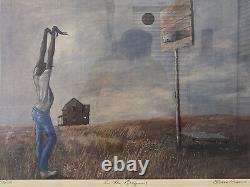
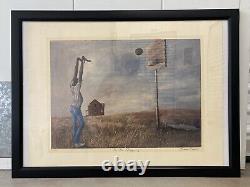
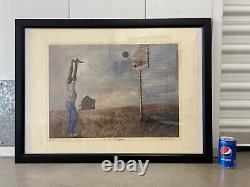

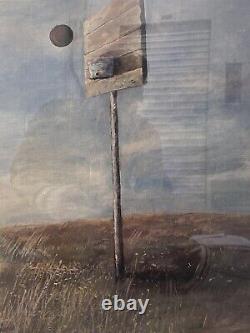
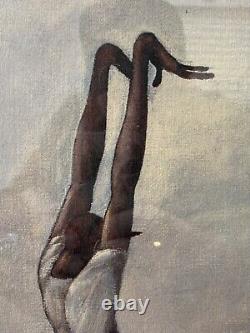
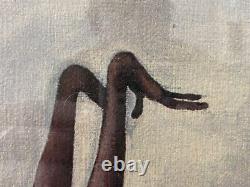
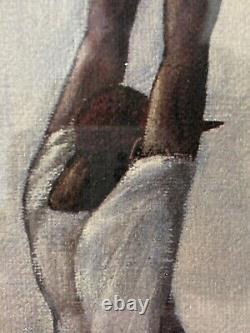
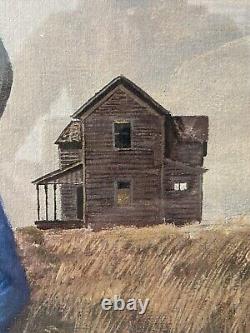
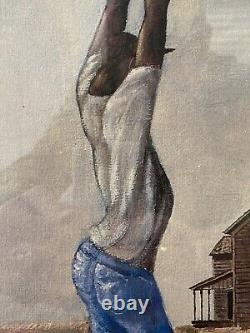
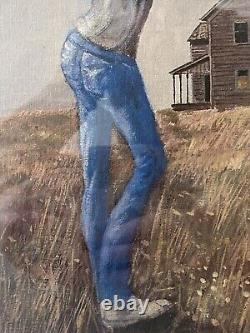

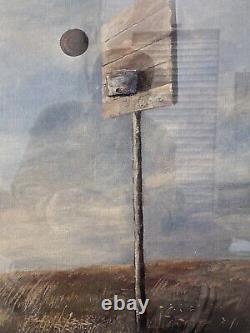




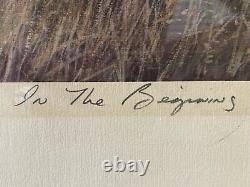
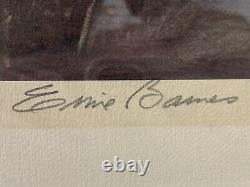

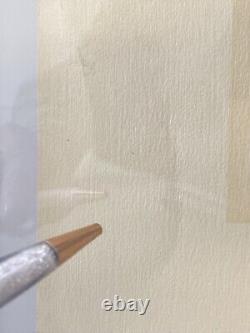





This is an Important and Very RARE Vintage African American Modern SIGNED Offset-Lithograph, created by Ernie Barnes in 1975, based on his original oil painting, titled In the Beginning. These works are very scarce today, commanding high prices from the few outlets who have managed to obtain some of these original lithographs, including the Ernie Barnes Foundation.
In the Beginning, a well-known painting by Barnes, depicts a young man shooting hoops in a barren field. His old Victorian style home is visible in the far distance. Hand numbered: "481/750, " in the lower left corner. Hand titled: "In The Beginning, " at the center edge, and hand signed by the artist: "Ernie Barnes" in graphite in the lower right corner. Approximately 22 1/8 x 30 1/8 inches including frame.Actual artwork is approximately 19 7/8 x 26 inches. Very good condition for age, with some mild smudges and creasing to the far edges, and light age-related toning and yellowing to the paper along the edges of the print please see photos. Acquired from the affluent estate collection of an African American art collector in Los Angeles County, California. If you like what you see, I encourage you to make an Offer. Please check out my other listings for more wonderful and unique artworks!
1938 - Durham, North Carolina. 2009 - Los Angeles, California. African-American figure, genre and sports painting.(1938 - 2009) was active/lived in California, North Carolina. Ernie Barnes Jr is known for African-American figure, genre and sports painting. Painter Ernie Barnes was born July 15, 1938 in Durham, North Carolina during the height of the Jim Crow Era.
He lived in a section of the city called "The Bottom" with his parents and younger brother, James. His father, Ernest Barnes, Sr. His mother, Fannie Geer, supervised the household for a prominent attorney who shared his extensive art book collection with the young "June" Barnes. By the time he began elementary school, Barnes was familiar with the Master artists. Bullied as a child for being shy and sensitive, Barnes found solace in drawing.
In his freshman year, a weightlifting coach put Barnes on a fitness program which taught him effort and discipline. By his senior year at segregated Hillside High School in Durham, Barnes was captain of the football team and state champion in the shot put. Barnes earned a full athletic scholarship to North Carolina College (now North Carolina Central University) where his art instructor, sculptor Ed Wilson, encouraged him to create images from his own life experiences. In 1960, Barnes was one of 30 African-Americans drafted into the National Football League.
One of nine players selected that year from a Historically Black College and University. For five seasons, Barnes was an offensive lineman for the New York Titans, San Diego Chargers and Denver Broncos. In 1965, New York Jets owner Sonny Werblin paid Barnes a season's salary "to paint" and subsequently sponsored the first Ernie Barnes art exhibition in a prestigious gallery.
After the success of the show, Barnes retired from football at age 28 and settled in Los Angeles, California to devote himself to art. Barnes is the first professional American athlete to become a noted painter. From his sports experience and the study of anatomy, Barnes' unique style of elongation captures the movement, energy and grace of his subjects. This earned him numerous appointments, including "Sports Artist of the 1984 Olympic Games" and "America's Best Painter of Sports" by the American Sport Art Museum & Archives.He was commissioned to paint artwork for the National Basketball Association, Los Angeles Lakers, Carolina Panthers, New Orleans Saints, Oakland Raiders, educational institutions, corporations, musicians, celebrities and professional athletes. His beloved painting, The Bench, that Barnes created in 1959 before his rookie season, was presented in 2014 to the Pro Football Hall of Fame.
In pop culture, Barnes artwork appears in television, movies and music album covers, including his famous dance hall scene, The Sugar Shack. His pride of North Carolina is evident in his artwork of pool halls, barber shops, porch ladies, church, street singers, sandlot games and other memories of growing up in the South. His commentary on dance, music, sports, women, education, social justice and everyday life continue to inspire viewers of all ages, race, religion, education and social status.
Barnes died of cancer on April 27, 2009. He is survived by his wife Bernie and his five children, Deidre, Michael, Sean, Erin and Paige. The current exhibition, The North Carolina Roots of Artist Ernie Barnes at the North Carolina Museum of History in Raleigh is an unprecedented success, with over 85,000 visitors and counting since July 2018. In May 2019, the exhibition Ernie Barnes: A Retrospective opens the California African American Museum in Los Angeles. Ernie Barnes' involvement with art began at an early age; however, when he reached high school his creative endeavors were temporarily detoured in his determination to become a successful athlete.In part this change was a response to the demands of peer pressure, which can be so strong at that age. He graduated from his high school a hero and star football player, and with a choice of 26 full athletic scholarships. He chose North Carolina Central University and a major in art. After college, he continued in a professional athletic career, but never let his love for football overshadow his love for art.
Football gave him an enormous satisfaction of achievement, of being able to do something extremely difficult, and do it well. Art, however, allowed him the privilege to interpret for the public his concepts of the relationship between art and life. In 1966, Ernie Barnes retired from football to commit himself to his art. His athletic career made a special contribution to his sensibility and his art, and he often weds physical with artistic expression. Many of his subjects are satirical, and he uses exaggeration, and even caricature, to enhance their mood, humor and physical vitality.Usig dramatic-comic vision, Barnes hopes that human figures will play out their roles in a contemporary scenario in a manner that is both entertaining and finely executed. INDIVIDUAL EXHIBITIONS 1979 o North Carolina Museum of Art, Raleigh, North Carolina 1976 o City Museum, Cedar Rapids, Iowa 1975 o Bedford Stuyvesant Restoration Center, Brooklyn, N. Y o North Carolina Central University, Durham, North Carolina 1974 o Museum of African Arts, Washington, D. 1973 o High Museum, Atlanta, Georgia 1972 o Science and Industry Museum, Los Angeles, Cal.
1971 o Elizabeth City State University, Elizabeth City, North Carolina o Agra Gallery, Washington, D. 1969 o Mckenzie Gallery, Los Angeles, California 1968 o Mckenzie Gallery, Los Angeles, California 1966 o Grand Central Art Gallery, New York Biography submitted on April 30, 2010. Biography from The Johnson Collection.
He has been celebrated as the most expressive painter of sports since George Bellows. " In his own words, Barnes's work offers "a pictorial background for an understanding into the aesthetics of black America. Born in Durham, North Carolina, during the Jim Crow years, Barnes did not have access to art museums.Instead, he familiarized himself with art history in the personal library of his mother's prominent employer. Bullied because of his weight as a youth, Barnes sought acceptance through athletics and relied on art as an emotional outlet. In 1956, Barnes enrolled at North Carolina College (now North Carolina Central University) on a full athletic scholarship and pursued a degree in art. One influential college instructor urged Barnes to translate the physical movement of his body on the football field to the canvas-a lesson Barnes never forgot. His sports and tavern paintings, populated with expressive, elongated figures reminiscent of Parmigianino or Michelangelo's later work, have been described as Neo-Mannerist.
These figures are most often depicted with their eyes closed, a practice Barnes adopted to illustrate "how blind we are to one another's humanity" and the tendency to stop at color. He preferred to present his paintings in frames made of distressed wood inspired by the ramshackle fence that had encircled his childhood home in Durham. After playing in the National Football League from 1960 to 1965, Barnes devoted himself to art, becoming the official artist of the NFL and, later, of the 1984 Olympics. He detailed his transition from professional athlete to artist in a 1995 autobiography, From Pads to Palette. His best-known work, Sugar Shack (circa 1970), was featured on the popular television show Good Times and, following some alterations, became the cover design for Marvin Gaye's 1976 I Want You album.
Barnes received numerous awards for his paintings, which continue to appear in exhibitions nationwide and are held in prominent private collections, as well as the California African American Museum. He died from a rare blood disorder in 2009. And, as he had requested, a portion of his ashes were spread over the site of his family's home in Durham. The Johnson Collection, Spartanburg, South Carolina.

